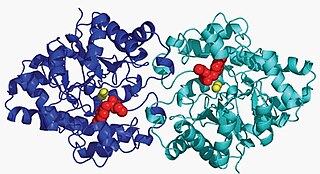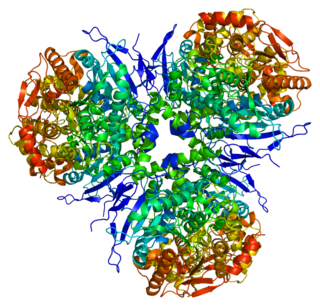
The enzyme cholinesterase (EC 3.1.1.8, choline esterase; systematic name acylcholine acylhydrolase) catalyses the hydrolysis of choline-based esters:
Hydrolase is a class of enzymes that commonly perform as biochemical catalysts that use water to break a chemical bond, which typically results in dividing a larger molecule into smaller molecules. Some common examples of hydrolase enzymes are esterases including lipases, phosphatases, glycosidases, peptidases, and nucleosidases.

Orotic acid is a pyrimidinedione and a carboxylic acid. Historically, it was believed to be part of the vitamin B complex and was called vitamin B13, but it is now known that it is not a vitamin.
An esterase is a hydrolase enzyme that splits esters into an acid and an alcohol in a chemical reaction with water called hydrolysis.

Terthiophene is the organic compound with the formula [C4H3S]2C4H2S. It is an oligomer of the heterocycle thiophene, a shorter oligomer is dithienyl, and the parent polymer is polythiophene. In the most common isomer of terthiophene, two thienyl groups are connected via their 2 positions to a central thiophene, also at the carbon atoms flanking the sulfur.
The enzyme 1-alkyl-2-acetylglycerophosphocholine esterase (EC 3.1.1.47) catalyzes the reaction
The enzyme 5-(3,4-diacetoxybut-1-ynyl)-2,2′-bithiophene deacetylase (EC 3.1.1.66) catalyzes the reaction
The enzyme acetyl-CoA hydrolase catalyzes the reaction
The enzyme acetylesterase (EC 3.1.1.6) catalyzes the reaction
The enzyme acetylsalicylate deacetylase (EC 3.1.1.55) catalyzes the reaction

Aryldialkylphosphatase is a metalloenzyme that hydrolyzes the triester linkage found in organophosphate insecticides:
The enzyme arylesterase (EC 3.1.1.2) catalyzes the reaction
The enzyme carboxylesterase (or carboxylic-ester hydrolase, EC 3.1.1.1; systematic name carboxylic-ester hydrolase) catalyzes reactions of the following form:
The enzyme cephalosporin-C deacetylase (EC 3.1.1.41) catalyzes the reaction
The enzyme methylumbelliferyl-acetate deacetylase (EC 3.1.1.56, esterase D) catalyzes the reaction

Liver carboxylesterase 1 also known as carboxylesterase 1 is an enzyme that in humans is encoded by the CES1 gene. The protein is also historically known as serine esterase 1 (SES1), monocyte esterase and cholesterol ester hydrolase (CEH). Three transcript variants encoding three different isoforms have been found for this gene. The various protein products from isoform a, b and c range in size from 568, 567 and 566 amino acids long, respectively.
The enzyme acetylajmaline esterase (EC 3.1.1.80, AAE, 2β(R)-17-O-acetylajmalan:acetylesterase, acetylajmalan esterase; systematic name 17-O-acetylajmaline O-acetylhydrolase) catalyses the following reactions:
The enzyme pyrethroid hydrolase (EC 3.1.1.88, pyrethroid-hydrolyzing carboxylesterase, pyrethroid-hydrolysing esterase, pyrethroid-hydrolyzing esterase, pyrethroid-selective esterase, pyrethroid-cleaving enzyme, permethrinase, PytH, EstP; systematic name pyrethroid-ester hydrolase) catalyses the reaction

2,2′-Bithiophene is the organic compound. It is a colorless solid, although commercial samples are often greenish. It is the most common of the three isomers with formula (C4H3S)2. The other two isomers have the connectivity 2,3′- and 3,3′-. The compound is typically prepared by cross-coupling starting from 2-halothiophenes.






